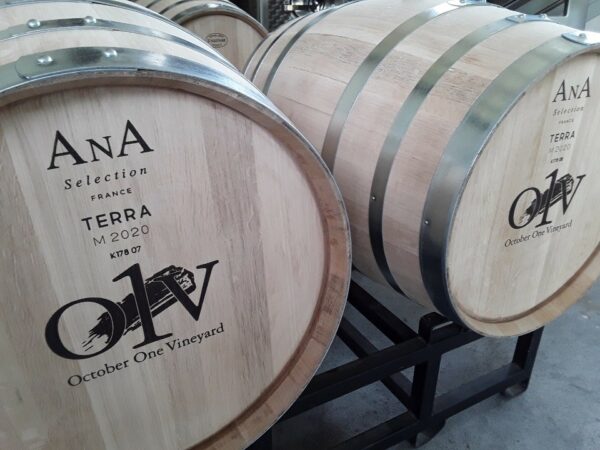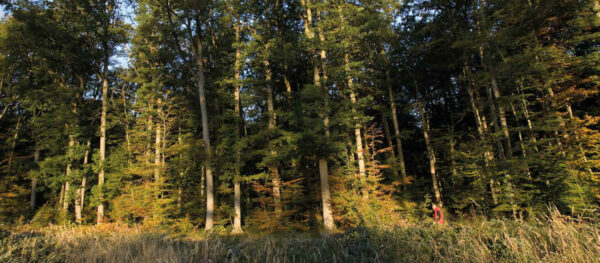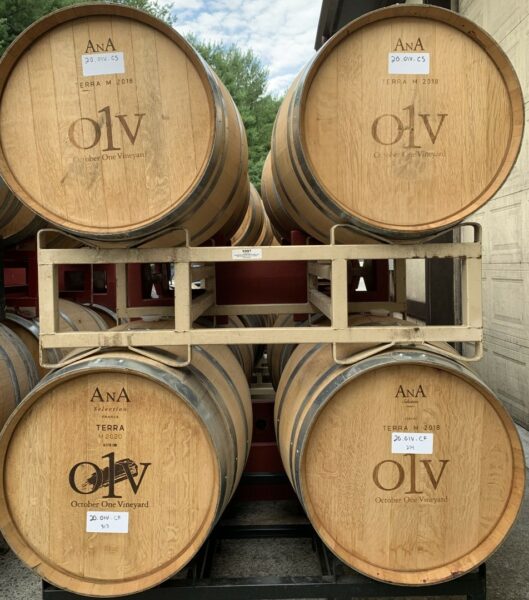Wine derives flavor from three sources. The primary source is grapes. Second is the fermentation process, and the last source is aging. When enjoying your next bottle of October One Vineyard wine, knowing the origin of the barrels used for aging and their contribution to your wine is the focus of this month’s blog article.
We enjoy many wines influenced by barrel aging, most generally oak barrels. Italy’s splendid Barolo spends years in oak, and the renowned Bordeaux wines are oak-influenced. Grand Reserve Riojas spend two years aging in American oak barrels. California Cabernet Sauvignon will certainly be oak-aged, and the list continues.
White wine is not frequently aged in oak due to preserving its delicate aroma and flavors, but some Chardonnay, Chenin Blanc, Sauvignon Blanc, and Viognier styles are barrel-aged, creating rich, full-bodied wines.
For example, October One Vineyard’s delicious 2021 Viognier is barrel fermented in oak and aged in Acacia and Neutral Oak barrels, giving it a nice round, weighty mouth-feel. Acacia wood aging is known in the industry for improving how wine feels in your mouth and adding floral notes without the woody flavors.
For aging October One Vineyard’s red wines, we generally use a twenty-five to seventy-five percent ratio of new to neutral oak.

October One Vineyard French Oak Barrels at Walsh Family Wines.
We have purchased and tried many barrel types over the years to arrive at the ones we feel work best for our wines. The Terra model oak barrels depicted above are used by October One Vineyard’s winemaker, Walsh Family Wines. The barrels are made in the town of Trie-sur-Baïse, near the city of Toulouse, in southwest France. The barrel-making company, AnA Selection, sources the best oak from managed forests in France and has this to say about the Terra model.
“Made from prestigious forest oak from the center of France, the TERRA barrel makes the authentic contributions needed for aromatic opulence in long-term aging, providing fullness and “sweetness” with great tannin elegance. The end of aging, integration takes place perfectly, with a blend of gentle spices and vanilla.” ~ anaselection.com
Origins of oak and flavor
The primary sources of oak trees for winemaking use are forests in the US, France, and Hungary. Each tree type has a unique flavor profile. American oak (Quercus alba) is bolder, more aromatic, has robust flavors, more intense vanilla, wood sugars, and toastiness, and allows more oxygen transfer to the wine that softens tannins.
French oak (Quercus sessilis, Quercus robur) offer a more subtle touch of oak flavors, less softening but adds good structure to the wine. Hungarian and French oak is the same type of tree, but Hungarian oak has more subtle flavors and delivers unique leather and black pepper notes.

A French Oak Forest, the source of October One Vineyard’s oak barrels.
Cooperage is an ancient art.
Before a cooper makes a barrel, cut raw oak is stacked on pallets to season for two to three years removing woody flavors and moisture. Once constructed, the cooper chars the barrels over an oak fire to varying degrees of toastiness. The barrels are made to order and toasted based on the winemaker’s needs.
The toasting process is vital to creating taste and aroma profiles in wine. The prescribed level is achieved by placing burning wood pieces inside the barrels and monitoring the temperature and duration of the toast. Think of the difference in the flavor of toasted bread from lightly toasted to charred.
The toast levels are Light, Medium, Medium Plus, and Heavy. The popular Medium Plus delivers a complete range of flavors and is suitable for rich red wines that need a complete and balanced oak impact. This toast level imparts tastes of brown sugar, vanilla, spice, and oakiness.
The most used barrel is called a barrique with a 60 US gallon (300 bottles) capacity that first appeared in Bordeaux, France. The impact of oak barrels diminishes over time, and their lifespan is typically three to five years; after that, many are destined for tables, planters, or wine storage.
Winemakers get fifty percent of a barrel’s extract in year one, twenty-five percent in year two, and less after that. New oak barrels in the first year impart intense toasty flavors; the second year is the best for extracting vanilla with well-balanced flavors. By the third year, flavors probably have diminished to calling the barrel neutral oak. Neutral oak is widely used and adds elegance to barrel aging without imparting strong flavors.
Watch this video on how barrels are made. ~ Jordan Vineyard and Winery
It’s common to see the origin of oak in wine descriptions and wine labels since it plays an essential role in improving wine’s taste and physical properties. All in all, oak gives winemakers a choice to enhance wine by applying oak as a chef does with the flavors from their spice rack!
For the record, buttery flavors do not come from oak! They are introduced due to Malolactic fermentation (MLF), which creates diacetyl, a chemical that tastes like butter or butterscotch. So lumping buttery and oaky together in a derogatory “buttery-oaky” descriptor as if they have a common source is inaccurate.
Wine would be dull without barrels!
There are two applications for wine barrels; aging wine and fermenting wine; the most common is aging. After fermentation in large vessels, wine is transferred to barrels for aging, where exquisite flavors of vanilla, sweet toasty aromas, tea, and tobacco are transferred to the wine. Also, flavors of smoke, spice, clove, caramel, cocoa, coffee, sweet peppers, dill, coconut, dried fruit, nuts, and burnt sugar come through as the wine and wood mingle.

Cabernet Franc and Cabernet Sauvignon gently aging in French oak barrels.
Fermenting wine in oak barrels is even more effective for flavor transfer from the wood to the wine. Fresh grape juice is transferred to barrels after harvest and crushing, where fermentation occurs. This results in a beautiful integration of the oak and wine flavors. The price of barrel-fermented wine is higher due to extra cellar work, and fermentation yeast can affect the barrels requiring time-consuming cleaning. Barrel fermentation is not used for all wine styles and can remove freshness and fruitiness; it’s reserved for making wine with body and structure.
Are you looking to sip, savor, and experience barrel-aged wine? Visit the October One Tasting shop to try our barrel-aged beauties. If you want to try our wines from the comfort of your home, you can conveniently shop at our online store by following this link, O1V wine shipped to you.